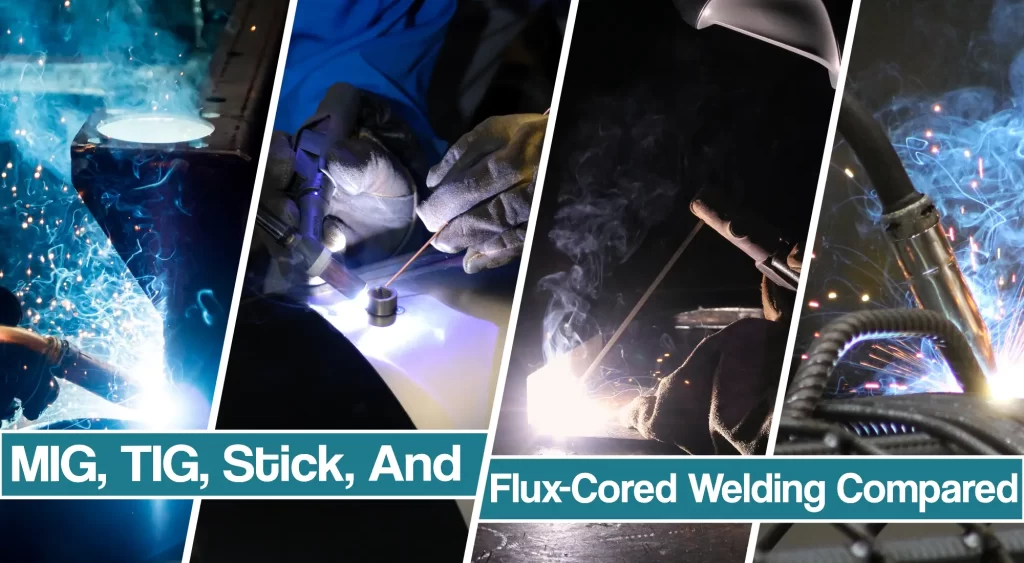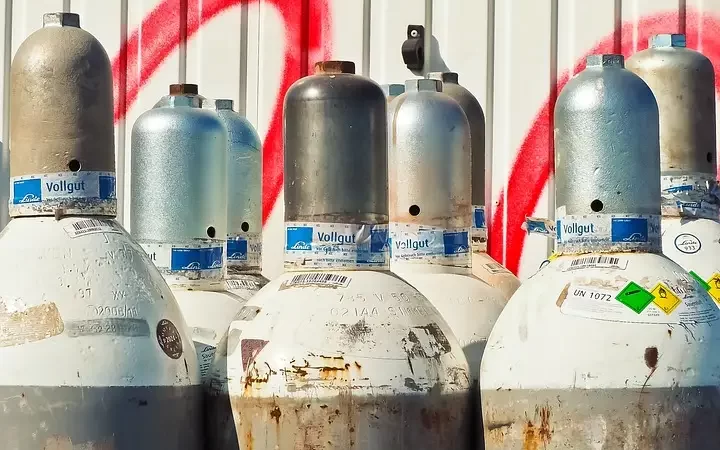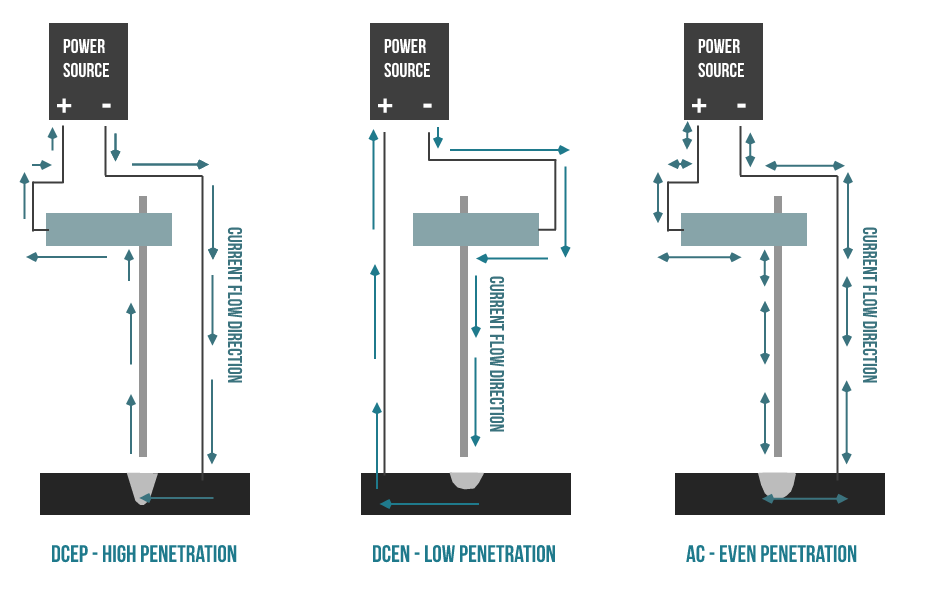The four standard welding processes used in most manual welding applications are MIG, TIG, stick, and flux-cored arc welding.
In this article, you’ll learn about their advantages and disadvantages, and what kind of work each is meant for. We will primarily discuss the manual application in an everyday welding environment and leave industrial use of these processes for another blog. This article aims to teach rookies the fundamentals of these welding processes.

Essentials You Must Know Before We Proceed With Comparisons
Every arc welding process requires some shielding agent from atmospheric contamination. The shielding action can come from a shielding gas (MIG and TIG) or the flux that turns into shielding slag (stick and flux-cored).
Another fundamental point is that these processes use electrical resistance to melt metals. The electrical circuit needs to be closed with the metal piece between the positive and the negative polarity for this to work.

So, the torch/gun/electrode holder is on one side, and the ground clamp is on another. They can be of either polarity, positive or negative. The electricity flows from the negative to the positive due to the laws of physics, but it’s up to us to attach the torch and the ground clamp to either of the terminals on the welder.
These four welding processes have specific polarity requirements you must follow to achieve good welding results. There are three options:

- DCEN – Direct current electrode negative means that the electrode lead is attached to the negative terminal, and the ground clamp is attached to the positive. Electricity flows from the electrode to the metal because the ground clamp is connected to the workpiece.
- DCEP – Direct current electrode positive means that the electrode is hooked to the positive terminal, while the ground is connected to the negative. Electricity flows from the metal to the electrode.
- AC – Alternating current switches between DCEN and DCEP many times per second and lets you use both of these to your advantage.
Everything I’ve discussed here will make more sense once we cover the specific welding processes. So, let’s get started.
MIG or Metal Inert Gas
MIG or GMAW (Gas metal arc welding) is the simplest process to master. MIG welding is used by professionals and hobbyists. It requires a shielding gas and uses a wire feeding system to feed filler metal into the weld pool.
How MIG Welding Works
To MIG weld, you have to set your leads to DCEP polarity. If you use DCEN, the arc will be unstable, and the welds will be poor.
The MIG welder uses a wire feeding system to feed the solid MIG wire from a spool. This wire is the electrode and the filler metal at the same time. Once the wire touches the metal piece, the arc is initiated. Depending on the wire feeding speed and voltage settings, you can have a short circuit, globular, spray, and pulse-spray transfer modes.
It is necessary to use a shielding gas for GMAW. Either 100% CO2 or 75% argon and 25% CO2. The gas tank is connected to the MIG machine, and the MIG gun supplies the gas over the weld pool, protecting it from atmospheric contamination. You can learn more here about MIG shielding gasses and their mixtures and which one is preferred over the other and when.
Advantages
- MIG welding is the easiest welding process to learn and has a wide array of applications. You can learn more about the most common MIG welding applications here.
- Produces less spatter than flux-cored or stick welding
- High strength welds
- MIG welds look good
- It can produce long welds with little downtime thanks to a continuous wire feeding system
- If welding with 100% CO2, the process is relatively cheap
- Filler metal comes in spools of various sizes
- MIG welding process supports many metals, including aluminum
- Works great with thinner materials
- Requires little to no post-weld cleaning
Disadvantages
- It can’t be used in windy conditions because the shielding gas can be blown away
- Not suitable for dirty metals (rust, oil, mill scale, grease, paint, etc.)
- Requires multiple elements to complete the equipment (MIG welder, gas tank, gas regulator, MIG wire, spool gun for aluminum)
FCAW or Flux-Cored Welding
The flux core arc welding process uses the wire feeding mechanism just like MIG. But it doesn’t require the shielding gas if a gasless flux-cored wire is used. It’s an excellent process for beginners, but it doesn’t provide as good results as MIG.
How Flux Cored Arc Welding Works
The FCAW welding process uses a flux-cored wire as a filler material and welding electrode. The wire is hollow, tubular, and made of mild steel or stainless steel. The hollow core is filled with flux during the wire fabrication and then closed with a seam joint.
This flux in the core of the wire burns off during the welding process and creates a shielding slag that forms on top of the weld.
This slag protects the weld pool from atmospheric contamination and uses hydrogen to its advantage, turning it from a contaminating element to a protective factor. This is why shielding gas is not needed. However, there are FCAW wires that do require a shielding gas, but those are not typically used in everyday welding.
Advantages
- Requiring no shielding gas, the FCAW is an excellent choice for welding outdoors
- It provides deeper penetration and faster deposition rate than MIG because the welding current is concentrated on a smaller metal area of the wire cross-section
- The flux can contain additional deoxidizers allowing you to weld dirtier metal with more impurities
- The equipment is more portable than MIG welding equipment
- Flux core wire doesn’t require wire clippers to cut off the tip because it can be broken off by hand
- All MIG welders support the flux core welding process
Disadvantages
- Flux-cored welding process releases much more smoke than MIG and even stick welding. It isn’t easy to see the welding pool, requiring more skills from the operator
- It is dangerous to weld indoors without sufficient ventilation due to released gasses
- The resulting welds from FCAW are not as good-looking as with the MIG welding process.
- Requires slag removal after welding and between each pass
- Requires post welding cleanup because FCAW creates a lot of sparks and molten metal bits that fly all over the welded piece
- Not recommended for welding thinner than 20 gauge
TIG or Tungsten Inert Gas Welding (GMAW)
The TIG welding process is the cleanest of all arc welding processes and produces the highest quality TIG welds. It’s most challenging to learn, and it’s used for critical welds.
It uses a shielding gas like MIG, but the filler rod is fed manually into the weld pool. You can also weld without a filler wire, which is sometimes advantageous compared to all other arc processes.
How TIG Welding Works
The gas tungsten arc welding process relies on shielding gas for weld protection and a non consumable tungsten electrode for arc ignition and welding. The tungsten electrode sticks out from the TIG welding torch and allows the electric arc to jump on the metal piece and complete the circuit.
The TIG welding supports DCEN, DCEP, and AC. The DCEN is mainly used when welding DC because it concentrates the heat on the metal, not tungsten. The AC alternates between these two, and it’s used to weld aluminum and other non-ferrous metals that need the cleaning action of DCEP.
The tungsten electrodes vary by their principal oxide. Each is meant for a different use case. You must match the tungsten type with the polarity and the appropriate welded metal to make a quality weld.
The shielding gas is pure 100% argon or a mixture with helium. Argon provides a stable, focused arc, while helium achieves deeper penetration.
Advantages
- Produces strong welds with beautiful-looking beads
- TIG welding allows you to make precise welds
- Excellent choice for welding thin metal
- Narrow heat affected zone
- No slag
- It doesn’t produce smoke, sparks, or molten bits. TIG is an extremely clean welding process
- Excellent visibility over the weld pool
- The most versatile welding process
Disadvantages
- Costly equipment (TIG welder, argon gas, etc.)
- Low filler metal deposition
- Slow welding speed
- Requires a lot of skill that can’t be obtained quickly
- Difficult to manage heat input
- The welding joint must be perfectly cleaned
Stick Welding or SMAW (Shielded Metal Arc Welding)
The stick welding process is the most rugged of all compared processes. It uses flux-coated rods and relies on a slag system for shielding against atmospheric contaminants and metal impurities.
It allows a lot of room for error, and it’s an economical method to run. Stick welding is the most popular welding method among hobbyists and DIY welders. But it’s also heavily used in a professional environment, especially for welding pipes.
While stick welding is easier to learn than TIG welding, it’s more challenging to master than MIG or flux-cored welding. The equipment is easy to set, but the technique is more difficult to learn. That’s because you have to maintain the arc length while the stick electrode is burning up and losing its length. Plus, it’s easy to burn through thin metal, and difficult to see the arc due to fumes and sparks.
How Stick Welding Works
The stick welding process joins metal by melting the flux coated consumable electrode and the base metal with the arc formed between the workpiece and the welding rod. Stick welding is performed with DC output most of the time, but sometimes AC welding has its advantages.
The DCEP polarity provides the best arc quality and penetration, while the DCEN is used when welding thinner materials to avoid burn through.
Many different electrodes are made for stick welding, and they serve different purposes. The most commonly used rods for mild steel welding are E6010, E6011, E6012, E6013, and E7018. You can read more about stick welding electrodes here, and use our calculator to get a match with the material you are welding.
Advantages
- Affordable equipment (welding machine, welding rods, etc.)
- Works great outdoors
- Rugged process, not very sensitive to metal cleanliness
- Powerful welding arc
- Very portable
- Many different welding rods with unique characteristics to match your needs
- Works with various materials (mild steel, stainless steel, alloy steel, cast iron, aluminum, copper, nickel alloys, etc.)
- Excellent for thicker materials
Disadvantages
- Challenging to learn
- Arc is more erratic than with other arc welding methods
- Produces a lot of smoke, sparks, and molten bits
- The resulting weld doesn’t look as good as MIG welded beads
- Slower than MIG or Flux core welding
- Requires slag removal between each pass
- Not very suitable for welding indoors due to large amounts of welding fumes
- Stick welders have limited adjustment settings and not many advanced features
Conclusion
The four types of welding we discussed in this article are complex and take a lot of time to master. However, the MIG welding method is the most straightforward and the best place to start.
This was a short overview. There is much more to be said about each of these processes. So, we invite you to look around our blog, especially the welding 101 section, to learn more.
Sources:
- Welding Principles And Applications book by Larry Jeffus
- Farm and Workshop Welding book by Andrew Pearce
- 4 Popular Types of Welding Procedures by Lincoln Tech





